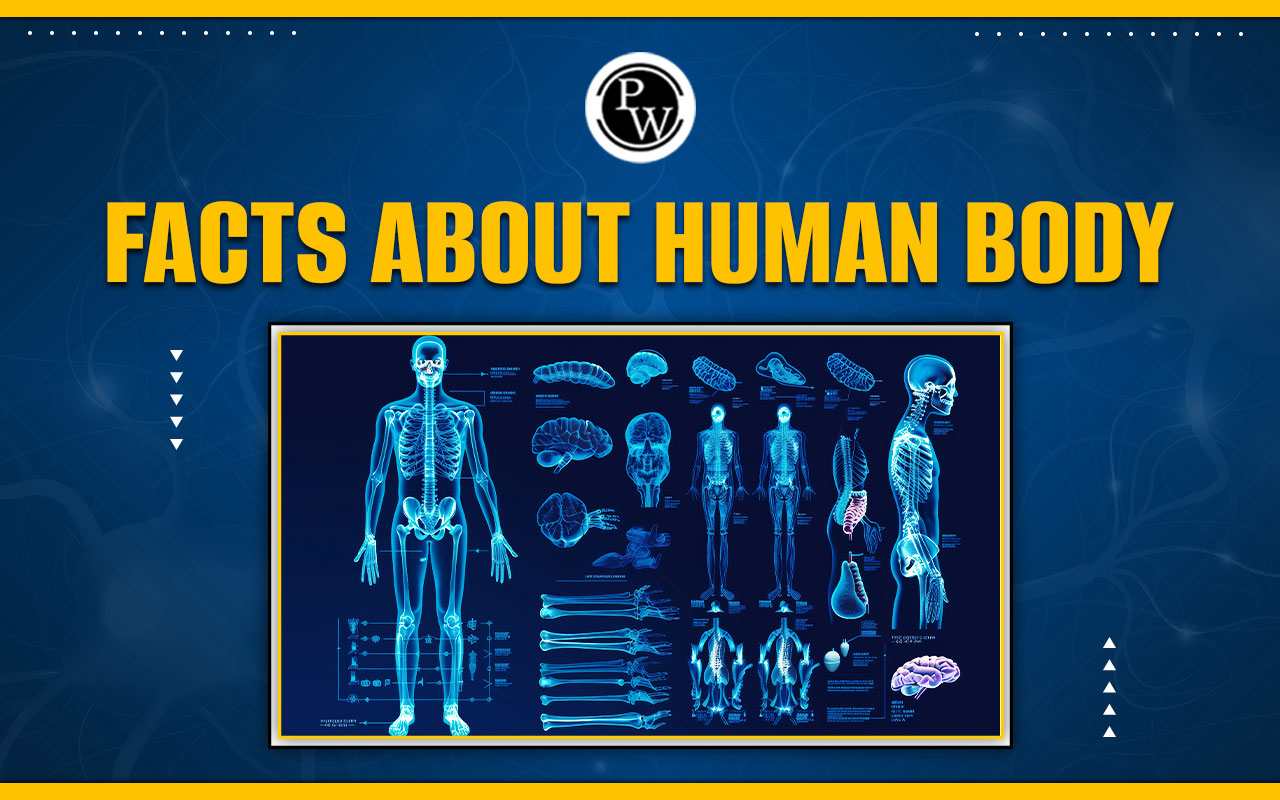

Human Body: In this article, we will delve into the fascinating world of the human body . We will cover the basics of the parts of the human body and their role in maintaining balance within the human body.
We will begin by defining the different human parts and systems and providing an overview of the heart, brain, skeleton etc. This will be followed by examining the digestive system, endocrine system etc. and their functions, including the circulatory, immune, circulatory system and others. We will delve into the process of hormone secretion and regulation, exploring the importance of maintaining balance within the endocrine system and the role of feedback mechanisms in this process. Additionally, we will discuss the impact of imbalances in hormone levels and the use of hormone replacement therapy to treat endocrine disorders. In conclusion, we will highlight the significance of the lymphatic system and its glands and hormones in overall human health and disease, emphasising the importance of proper lymphatic function and the consequences of lymphatic dysfunction.Introduction
The human body is a marvel of engineering and one of the most complex systems known to man. The body comprises numerous parts, each critical in keeping us alive and functioning properly. From the beating of our hearts to the movement of our limbs, the human body is a complex and sophisticated machine that is constantly adapting and changing. This article will explore some of the most fascinating facts about the human body.The Body Parts
The different human body parts with their functions areThe Heart
The heart is one of the most important organs in the human body and is responsible for pumping blood throughout the body. The average human heart beats approximately 100,000 times daily and pumps about 2,000 gallons of blood daily. The heart can also feel emotions like love and fear, which can cause physical changes, such as an increased heart rate. Additionally, the heart can repair itself and is the only muscle capable of doing so.The Brain
The brain is the most complex organ in the human body and controls all our thoughts, movements, and sensations. The average human brain weighs about 3 pounds and contains 100 billion neurons, each connected to thousands of other neurons. The brain also controls our memory, language, and emotions and can adapt and change throughout our lives.Environmental Issues and Solutions
The Skeleton
The skeleton is the framework of the human body and is made up of 206 bones. The skeleton's bones serve several important functions, including providing support and protection and allowing for movement. The skeleton's bones also store minerals such as calcium, essential for maintaining strong bones and good health. The skeleton also helps produce blood cells, critical for maintaining good health.The Muscles
The muscles of the human body are responsible for movement and help to maintain posture. The average human body contains over 600 muscles, and each muscle can contract and relax to move. The human muscles also play a critical role in regulating blood flow and maintaining good posture. Additionally, the human body's muscles play a role in regulating body temperature and are responsible for generating heat.The Skin
The skin plays several important roles, including protecting the body from the environment, regulating body temperature, and sensing touch and pressure. The skin is also responsible for producing vitamin D, essential for good health. The skin is constantly renewing itself and shedding dead skin cells, which helps to keep it healthy and looking young.The Lungs
The lungs are responsible for bringing oxygen into the body and removing carbon dioxide. The average person takes about 20,000 breaths daily, and the lungs can expand and contract to accommodate the body's changing needs. The lungs also play a critical role in regulating blood pressure and produce nitric oxide, which helps regulate blood flow. The lungs also help filter harmful particles from the air, protecting the body from potential harm.The Different Systems of the Human Body
The different systems of the human body are as followsThe Digestive System
The digestive system is responsible for breaking down food into smaller pieces that can be absorbed into the bloodstream. The digestive system includes the mouth, oesophagus, stomach, small intestine, large intestine, rectum, and anus. The digestive system is also responsible for eliminating waste from the body.The Endocrine System
The endocrine system produces and secretes hormones, which regulate many of the body's functions, including growth and development, metabolism, and reproductive function. The endocrine system includes the hypothalamus, pituitary gland, thyroid gland, adrenal glands, pancreas, ovaries (in women) and testes (in men).The Immune System
The immune system protects the body against foreign invaders like bacteria, viruses, and other harmful substances. The immune system includes white blood cells, antibodies, and the lymphatic system. When the immune system works properly, it can quickly identify and eliminate harmful invaders. Still, when it is not functioning properly, it can lead to infections and autoimmune disorders.The Circulatory System
The circulatory system transports blood, oxygen, and nutrients throughout the body. Blood is pumped from the heart through the blood vessels to the rest of the body, delivering oxygen and nutrients and collecting waste products.The Nervous System
The nervous system is responsible for transmitting signals and coordinating the body's responses to the environment. The nervous system includes the brain, spinal cord, and nerves. The nervous system transmits signals between the brain and the rest of the body, allowing for movement, sensation, and perception.The Reproductive System
The reproductive system is responsible for producing and transporting gametes (sperm or eggs) and supporting a fetus's growth and development. The reproductive system in men includes the testes, sperm ducts, prostate gland, and penis, while the reproductive system in women includes the ovaries, fallopian tubes, uterus, and vagina. The reproductive system is essential for reproduction and the continuation of the species.The Respiratory System
The respiratory system includes the nose, throat, trachea, bronchi, and lungs. When we breathe, oxygen is taken into the lungs and exchanged with carbon dioxide, exhaled.The Musculoskeletal System
The musculoskeletal system supports and protects the body and allows for movement. The musculoskeletal system includes bones, joints, ligaments, tendons, and muscles. The bones provide support and structure, while the muscles and joints work together to allow movement.The Urinary System
The urinary system filters waste products from the bloodstream and eliminates them from the body. The urinary system includes the kidneys, ureters, bladder, and urethra. The kidneys filter waste from the bloodstream and create urine, which is then stored in the bladder until it is eliminated from the body.The Integumentary System
The integumentary system protects the body and regulates body temperature. The skin protects the body from the environment, while the sweat glands help regulate body temperature.The Sensory System
The sensory system allows us to experience the world through our senses, including sight, hearing, touch, taste, and smell. The eyes allow us to see, while the ears allow us to hear, and so on.The Lymphatic System
The lymphatic system removes waste and excess fluid from the body. The lymph vessels collect waste and fluid from the tissues and transport it to the lymph nodes, which are filtered and either eliminated from the body or returned to the bloodstream.Related Links -
The Human Body's Cells
The human body is composed of trillions of cells, each of which plays a specific role in maintaining the body's overall health and function. Here are some key facts about human body cells:- Types of Cells: There are two main types of cells in the human body: eukaryotic cells and prokaryotic cells. Eukaryotic cells are larger and more complex and include organ, tissue, and bone cells. Prokaryotic cells are smaller and simpler and include bacteria and other microorganisms.
- Cell Size: Human cells vary in size, with some being just a few micrometres in diameter and others being several centimetres long.
- Cell Structure: All human cells have a cell membrane that separates the inside of the cell from the outside environment. Inside the cell is a cytoplasm containing organelles, such as the nucleus, mitochondria, and endoplasmic reticulum.
- Cell Division: Human cells divide and replicate through mitosis. This allows the body to replace damaged or dying cells and to grow and repair tissues.
- Cell Specialization: Some human cells are specialised to perform specific functions. For example, muscle cells are specialised for contraction, while nerve cells are specialised for transmitting electrical signals.
- Stem Cells: Stem cells are unspecialised cells that can differentiate into different cell types and to self-renew. They play a critical role in developing, repairing, and treating certain diseases and conditions.
Human Body <span style=
Q1. Human Body has how many bones?
Ans- The human body comprises 206 bones.
Q2. What is the function of the heart?
Ans- The heart pumps blood throughout the body and maintains circulation.
Q3. What is the average weight of the human brain?
Ans- The average weight of the human brain is about 3 pounds.
Q4. What is the largest organ in the human body?
Ans- The largest organ in the human body is the skin.
Q5. What is the role of the skeleton in the human body?
Ans- The skeleton provides support and protection and allows for movement. It also stores minerals and helps to produce blood cells.
🔥 Trending Blogs
Talk to a counsellorHave doubts? Our support team will be happy to assist you!

Free Learning Resources
PW Books
Notes (Class 10-12)
PW Study Materials
Notes (Class 6-9)
Ncert Solutions
Govt Exams
Class 6th to 12th Online Courses
Govt Job Exams Courses
UPSC Coaching
Defence Exam Coaching
Gate Exam Coaching
Other Exams
Know about Physics Wallah
Physics Wallah is an Indian edtech platform that provides accessible & comprehensive learning experiences to students from Class 6th to postgraduate level. We also provide extensive NCERT solutions, sample paper, NEET, JEE Mains, BITSAT previous year papers & more such resources to students. Physics Wallah also caters to over 3.5 million registered students and over 78 lakh+ Youtube subscribers with 4.8 rating on its app.
We Stand Out because
We provide students with intensive courses with India’s qualified & experienced faculties & mentors. PW strives to make the learning experience comprehensive and accessible for students of all sections of society. We believe in empowering every single student who couldn't dream of a good career in engineering and medical field earlier.
Our Key Focus Areas
Physics Wallah's main focus is to make the learning experience as economical as possible for all students. With our affordable courses like Lakshya, Udaan and Arjuna and many others, we have been able to provide a platform for lakhs of aspirants. From providing Chemistry, Maths, Physics formula to giving e-books of eminent authors like RD Sharma, RS Aggarwal and Lakhmir Singh, PW focuses on every single student's need for preparation.
What Makes Us Different
Physics Wallah strives to develop a comprehensive pedagogical structure for students, where they get a state-of-the-art learning experience with study material and resources. Apart from catering students preparing for JEE Mains and NEET, PW also provides study material for each state board like Uttar Pradesh, Bihar, and others
Copyright © 2025 Physicswallah Limited All rights reserved.











